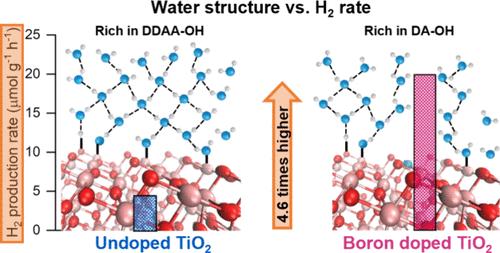当前位置:
X-MOL 学术
›
J. Am. Chem. Soc.
›
论文详情
Our official English website, www.x-mol.net, welcomes your feedback! (Note: you will need to create a separate account there.)
Water Structure in the First Layers on TiO2: A Key Factor for Boosting Solar-Driven Water-Splitting Performances
Journal of the American Chemical Society ( IF 14.4 ) Pub Date : 2024-06-23 , DOI: 10.1021/jacs.4c05042 Rosaria Verduci 1 , Fabrizio Creazzo 2 , Francesco Tavella 3 , Salvatore Abate 3 , Claudio Ampelli 3 , Sandra Luber 2 , Siglinda Perathoner 3 , Giuseppe Cassone 4 , Gabriele Centi 3 , Giovanna D’Angelo 1
Journal of the American Chemical Society ( IF 14.4 ) Pub Date : 2024-06-23 , DOI: 10.1021/jacs.4c05042 Rosaria Verduci 1 , Fabrizio Creazzo 2 , Francesco Tavella 3 , Salvatore Abate 3 , Claudio Ampelli 3 , Sandra Luber 2 , Siglinda Perathoner 3 , Giuseppe Cassone 4 , Gabriele Centi 3 , Giovanna D’Angelo 1
Affiliation

|
The water hydrogen-bonded network is strongly perturbed in the first layers in contact with the semiconductor surface. Even though this aspect influences the outer-sphere electron transfer, it was not recognized that it is a crucial factor impacting the solar-driven water-splitting performances. To fill this gap, we have selected two TiO2 anatase samples (with and without B-doping), and by extensive experimental and computational investigations, we have demonstrated that the remarkable 5-fold increase in water-splitting photoactivity of the B-doped sample cannot be ascribed to effects typically associated to enhanced photocatalytic properties, such as band gap, heterojunctions, crystal facets, and other aspects. Studying these samples by combining FTIR measurements under controlled humidity with first-principles simulations sheds light on the role and nature of the first-layer water structure in contact with the photocatalyst surfaces. It turns out that the doping hampers the percolation of tetrahedrally coordinated water molecules while enhancing the population of topological H-bond defects forming approximately linear H-bonded chains. This work unveils how doping the semiconductor surface affects the local electric field, determining the water splitting rate by influencing the H-bond topologies in the first water layers. This evidence opens new prospects for designing efficient photocatalysts for water splitting.
中文翻译:

TiO2 第一层的水结构:提高太阳能驱动水分解性能的关键因素
在与半导体表面接触的第一层中,水氢键网络受到强烈扰动。尽管这个方面影响了外层电子转移,但人们并没有意识到它是影响太阳能驱动的水分解性能的关键因素。为了填补这一空白,我们选择了两个 TiO 2 锐钛矿样品(有和没有 B 掺杂),并通过广泛的实验和计算研究,我们证明了水分解能力显着提高了 5 倍B 掺杂样品的光活性不能归因于通常与增强光催化性能相关的效应,例如带隙、异质结、晶面和其他方面。通过将受控湿度下的 FTIR 测量与第一原理模拟相结合来研究这些样品,揭示了与光催化剂表面接触的第一层水结构的作用和性质。事实证明,掺杂阻碍了四面体配位水分子的渗透,同时增加了形成近似线性氢键链的拓扑氢键缺陷的数量。这项工作揭示了半导体表面掺杂如何影响局部电场,通过影响第一水层中的氢键拓扑来确定水分解速率。这一证据为设计用于水分解的高效光催化剂开辟了新的前景。
更新日期:2024-06-23
中文翻译:

TiO2 第一层的水结构:提高太阳能驱动水分解性能的关键因素
在与半导体表面接触的第一层中,水氢键网络受到强烈扰动。尽管这个方面影响了外层电子转移,但人们并没有意识到它是影响太阳能驱动的水分解性能的关键因素。为了填补这一空白,我们选择了两个 TiO 2 锐钛矿样品(有和没有 B 掺杂),并通过广泛的实验和计算研究,我们证明了水分解能力显着提高了 5 倍B 掺杂样品的光活性不能归因于通常与增强光催化性能相关的效应,例如带隙、异质结、晶面和其他方面。通过将受控湿度下的 FTIR 测量与第一原理模拟相结合来研究这些样品,揭示了与光催化剂表面接触的第一层水结构的作用和性质。事实证明,掺杂阻碍了四面体配位水分子的渗透,同时增加了形成近似线性氢键链的拓扑氢键缺陷的数量。这项工作揭示了半导体表面掺杂如何影响局部电场,通过影响第一水层中的氢键拓扑来确定水分解速率。这一证据为设计用于水分解的高效光催化剂开辟了新的前景。











































 京公网安备 11010802027423号
京公网安备 11010802027423号